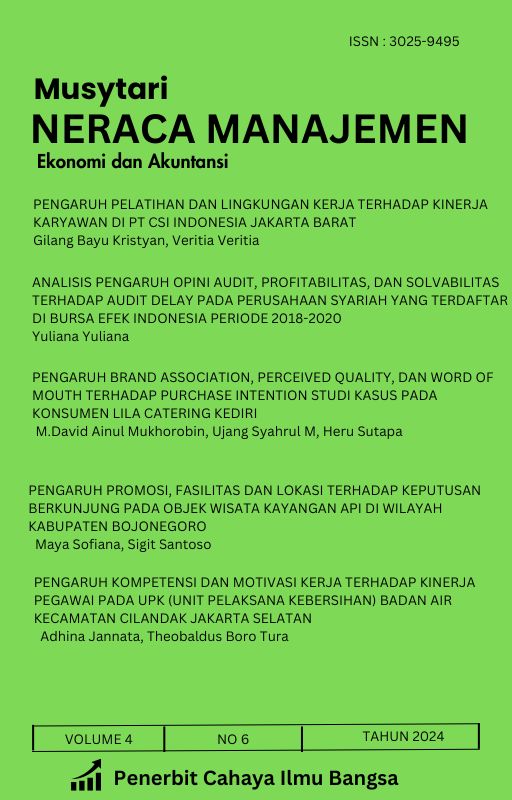ANALISIS PERBANDINGAN PERILAKU KONSUMSI BERDASARKAN SUMBER DANA MAHASISWA MENGGUNAKAN UJI ANOVA
Main Article Content
Abstract
This study examines the differences in student consumption behavior based on their primary sources of funding: parental support, scholarships, and personal income. As technology and social environments evolve, student spending habits both online and offline become more dynamic and susceptible to various economic and behavioral influences. The research utilizes a quantitative approach with a parametric comparative method, employing a One Way ANOVA test to determine whether significant differences exist among the three groups. Data were collected through an online questionnaire distributed to 100 undergraduate students. The results show that students receiving funds from parents dominate the sample (78%), followed by those on scholarships (12%) and those with personal income (10%). All 21 consumption behavior items were valid, and the instrument showed high reliability with a Cronbach’s Alpha of 0.864. Normality and homogeneity tests confirmed the data met the assumptions for ANOVA analysis. However, the ANOVA results showed no significant differences in consumption behavior among the three groups. This indicates that student consumption patterns are relatively uniform, regardless of funding sources. The similarity may be driven more by social influence, urban lifestyle, and easy access to digital services than by financial background.
Downloads
Article Details
Section

This work is licensed under a Creative Commons Attribution-NonCommercial-ShareAlike 4.0 International License.
How to Cite
References
[1] A. Krisnawati, "Financial Literacy and Behavioral Bias Towards Consumptive Behavior: Evidence from Bandung, Indonesia," MIMBAR: Jurnal Sosial Dan Pembangunan, vol. 2021, no. 79, pp. 353–361, 2023.
[2] S. Lestari, T. Yuniarsih, N. Fattah, and E. Ahman, "Economic Literacy and Student Consumption Behavior," in Proc. 1st Int. Conf. on Economics and Social Science (ICES 2018), vol. 214, pp. 166–168, 2019.
[3] S. M. Anjani, N. Rahmawati, R. Z. Oktiani, and S. Hanina, “Perilaku Konsumtif Mahasiswa UIN Sunan Gunung Djati Bandung Dalam Menggunakan Aplikasi Online Food Delivery ( OFD ) Secara Implusif,” vol. 3, no. 2, pp. 1331–1338, 2024.
[4] A. S. Asih, A. F. Az Zahra, F. I. Gisa, R. Kamila, K. N. Hafidhlatul H., K. Siva, and M. L. Wardiyah, "Analisis kurva permintaan celengan sebagai barang halal dalam meningkatkan surplus konsumen terhadap perubahan margin perusahaan dagang," Neraca: Jurnal Ekonomi, Manajemen dan Akuntansi, vol. 2, no. 7, pp. 20-27, Jun. 2024.
[5] Sugiyono, Metode Penelitian Kuantitatif, Kualitatif, dan R&D, Bandung: Alfabeta, 2021.
[6] R. W. Emerson, “ANOVA assumptions,” J. Vis. Impair. Blind., vol. 116, no. 4, pp. 585–586, 2022.
[7] A. Joshi, S. Kale, S. Chandel, and D. K. Pal, “Likert scale: Explored and explained,” Br. J. Appl. Sci. Technol., vol. 7, no. 4, pp. 396–403, 2015.
[8] B. Lantz, “Equidistance of Likert-Type Scales and Validation of Inferential Methods Using Experiments and Simulations,” Electron. J. Bus. Res. Methods, vol. 11, no. 1, pp. 16–28, 2013.
[9] S. Ishtiaq and S. Ishtiaq, “Reliability and validity: Importance in medical research,” J. Pak. Med. Assoc., vol. 71, no. 10, pp. 2401–2406, 2021.
[10] M. Tavakol and R. Dennick, “Making sense of Cronbach’s alpha,” Int. J. Med. Educ., vol. 2, pp. 53–55, 2011.
[11] A. Khoirunnisa, A. N. Gumilar, F. Aziz, G. Z. Aulia, J. Nuryanti, and M. L. Wadiyah, “Analisis minat mahasiswa terhadap penggunaan e-wallet sebagai alat transaksi,” NERACA: J. Ekon., Manaj. dan Akunt., vol. 2, no. 6, pp. 518–525, 2024.
[12] M. L. Wadiyah, N. N. Hudiah, R. A. Rabbani, S. M. Arham, S. N. Azizah, T. J. Dewi, and Z. Yamin, “Analisis penggunaan mobile banking terhadap minat belanja mahasiswa di online store,” NERACA: J. Ekon., Manaj. dan Akunt., vol. 2, no. 7, pp. 336–342, 2024.
[13] S. M. Anjani, N. Rahmawati, R. Z. Oktiani, S. Hanina, S. L. Anggraeni, T. A. Pangestu, and M. L. Wardiyah, “Perilaku konsumtif mahasiswa UIN Sunan Gunung Djati Bandung dalam menggunakan aplikasi online food delivery (OFD) secara implusif,” J. Ilmu Sosial, Manaj., dan Akunt. (JISMA), vol. 3, no. 2, pp. 1331–1338, 2024.
[14] M. M. Sanaky, L. M. Saleh, and H. D. Titaley, “Analisis faktor-faktor penyebab keterlambatan pada proyek pembangunan gedung asrama MAN 1 Tulehu Maluku Tengah,” J. Simetrik, vol. 11, no. 1, pp. 432–439, 2021.
[15] L. N. Hasanah and C. D. S. Indrawati, “Pengaruh micro teaching dan pengenalan lapangan persekolahan terhadap kesiapan menjadi guru pada mahasiswa FKIP UNS,” J. Inf. dan Komun. Adm. Perkantoran, vol. 8, no. 5, pp. 459–467, 2024.
[16] R. Palupi and A. E. Prasetya, “Pengaruh implementasi content management system terhadap kecepatan kinerja menggunakan One Way ANOVA,” J. Ilmiah Informatika, vol. 10, no. 1, pp. 74–79, 2022.
[17] A. Sayuti, B. Santoso, and I. N. N. A. Putra, “Pengungkapan lingkungan: Studi pada struktur kepemilikan dan tipe industri,” J. EMBA, vol. 8, no. 2, pp. 9–20, 2020.
